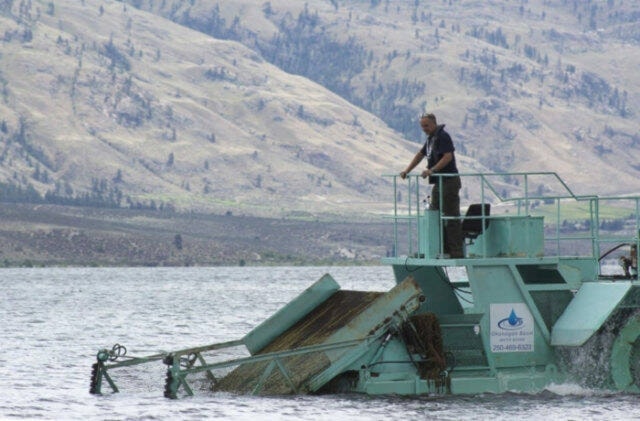Milfoil is blooming early in Okanagan Valley lakes this summer.
Milfoil harvesting efforts have already started in Osoyoos and Vaseux lakes to the south, and Wood Lake in the Central Okanagan, says James Littley, chief operating officer for the Okanagan Basin Water Board.
In his report to the board at its Aug. 5 meeting, Littley says milfoil harvesting in Osoyoos Lake started two weeks ahead of schedule.
"In the first month alone, we removed over 300 cubic metres of yards – enough to cover a hockey rink with six inches of milfoil or fill a curling sheet nearly four feet deep," Littley stated in his report.
He added that milfoil harvesting requests for Duck Lake have also been received, but the lake is only reachable by an amphibious harvester via private property.
"Given the lack of public access and beaches, it remains a lower priority compared to other sites. However, we continue to explore options," said Littley.
Meanwhile, the new milfoil harvester is due for arrival this month, replacing a 1978 model that has reached the end of its service life.
***
The OBWB continues to advocate for its efforts to step up prevention efforts of an invasive mussel infestation in the province.
On June 10, James Littley, chief operating officer for the OBWB, made a presentation to the Select Standing Committee on Finance and Government Services, calling for additional funding to the Invasive Mussel Defence Program to a minimum of $5.5 million annually, and for the establishment of a one-time $5 million emergency response and program expansion fund.
This contingency could be used for an initial response to invasive mussels showing up in B.C. lakes or to expand vessel inspection protocols.
The OBWB is also working on the development of a Regional Invasive Mussel Response Plan, the first of its kind in B.C.
In 2015, the province developed an Early Detection Rapid Response Plan, outlining the actions needed to detect mussels early and a preliminary rapid response plan, but the OBWB says that plan doesn't get into regional or water-body specific detail on how to respond, potentially leading to a slower response time while the information is gathered to produce a site-specific response after detection.
One of the goals of the more advanced plan is to provide provincial authorities and local stakeholders with a ready-to-use toolkit for a day-one response to the detection of mussels.
The toolkit information would include a given lake's water chemistry, boat and launch and access point locations, local agency and First Nations contacts and key community partners.
•�Ģ�Ģ
OBWB executive director Melissa Tesche was joined by board chair Blair Ireland for her presentation to the federal Liberal Pacific Caucus meeting held July 14-15 in 91���Ѽ.
Tesche's presentation covered the three main OBWB federal government talking points: The looming water infrastructure costs facing communities, the threat of invasive mussels and the need for more equity in federal funding.
Tesche made a specific reference to the Canada Water Agency's funding disparity, which will see less than two per cent of the total funding make it to B.C., with the Okanagan entirely excluded from any funding support.
Tesche reports that local 91���Ѽ MP Stephen Fuhr's office has followed up on the caucus presentation, requesting more information.
***
Consultant Allan Neilson, with Nelson Strategies Inc., has been retained to oversee the development of a new strategic plan for the OBWB.
Neilson has worked with various civic governments across the province over the past 20 years, his most recent posting as general manager of planning, policy and environment for the Metro Vancouver Regional District.
The formal engagement process with the public and water stakeholders will begin in October, with a final draft of the plan submitted to the March 2026 board meeting.
***
The next Water Stewardship Council meeting will be Sept. 11, 12 to 4 p.m., at the Coast Capri Hotel.
Keynote speaker will be Dr. Cassidy Rankins, speaking about satellite remote sensing technologies that support water management.
These technologies improve the quality of real-time data for decision-making on various water quality and quantity issues, including flooding and bacterial blooms.
The council also continues to be involved in a myriad of research-gathering projects, such as hydrometric station monitoring, developing an Okanagan wetlands strategy, working with UBCO faculty on agricultural irrigation economics, and creating a real-time cyanobacteria risk alerting system in partnership with the City of 91���Ѽ and Westbank First Nation.
***
The race is tightening to crown the Make Water Work Community Champion for 2025.
As of Aug. 7, Armstrong was sitting in the lead with 124 pledges, with the communities of Oliver and Osoyoos on their heels with 101 and 86 pledges, respectively.
While the contest for the public runs until October, the Community Champion will be crowned at the Sept. 5 annual general meeting of the OBWB in 91���Ѽ.
This year has seen a record-setting pledge count, sitting at 490 as of July 30.
The pledges are meant to reflect water conservation and FireSmart landscaping initiatives to build community resilience against drought and wildfires.
Residents can submit a pledge online at .
***
The weather statistics from mid-May to early July reflect what most local residents have likely noticed - temperatures have remained relatively stable within the warm to normal range so far this summer across the Okanagan with an absence of an extended extreme heat spell.
Last year, July recorded the most days exceeding 35 C on record. So far this summer, the extremely hot days have been limited to around 2-3.
Overall, the valley has not accumulated as much precipitation as usual for this time of year, falling below normal compared to the last 30 years, except in 91���Ѽ, where the rain has reached a close to normal range.
The Environment and Climate Change Canada longer-term seasonal forecast shows a high possibility of above-normal temperatures in the Okanagan over the next three months and below-normal rainfall.



